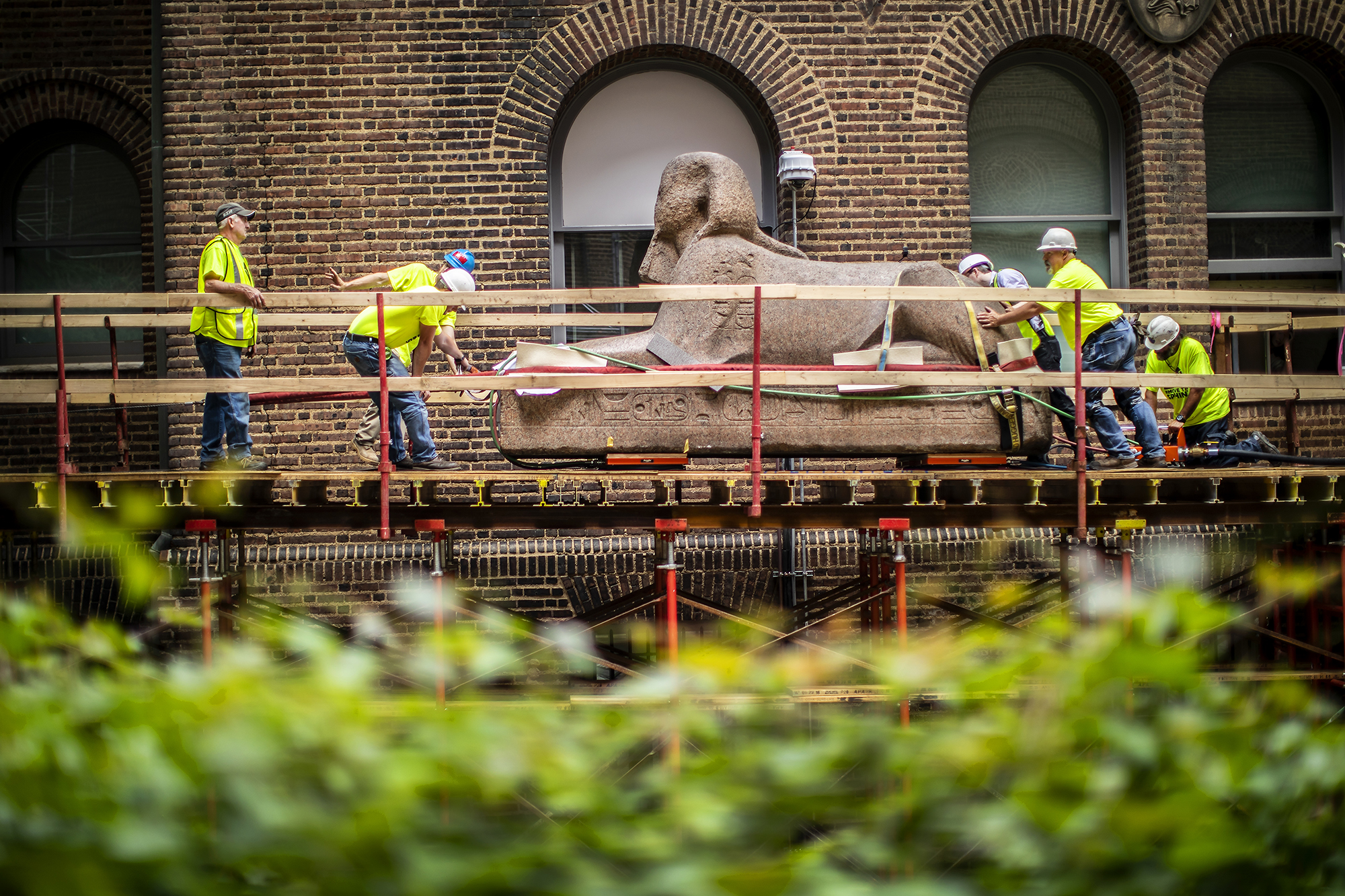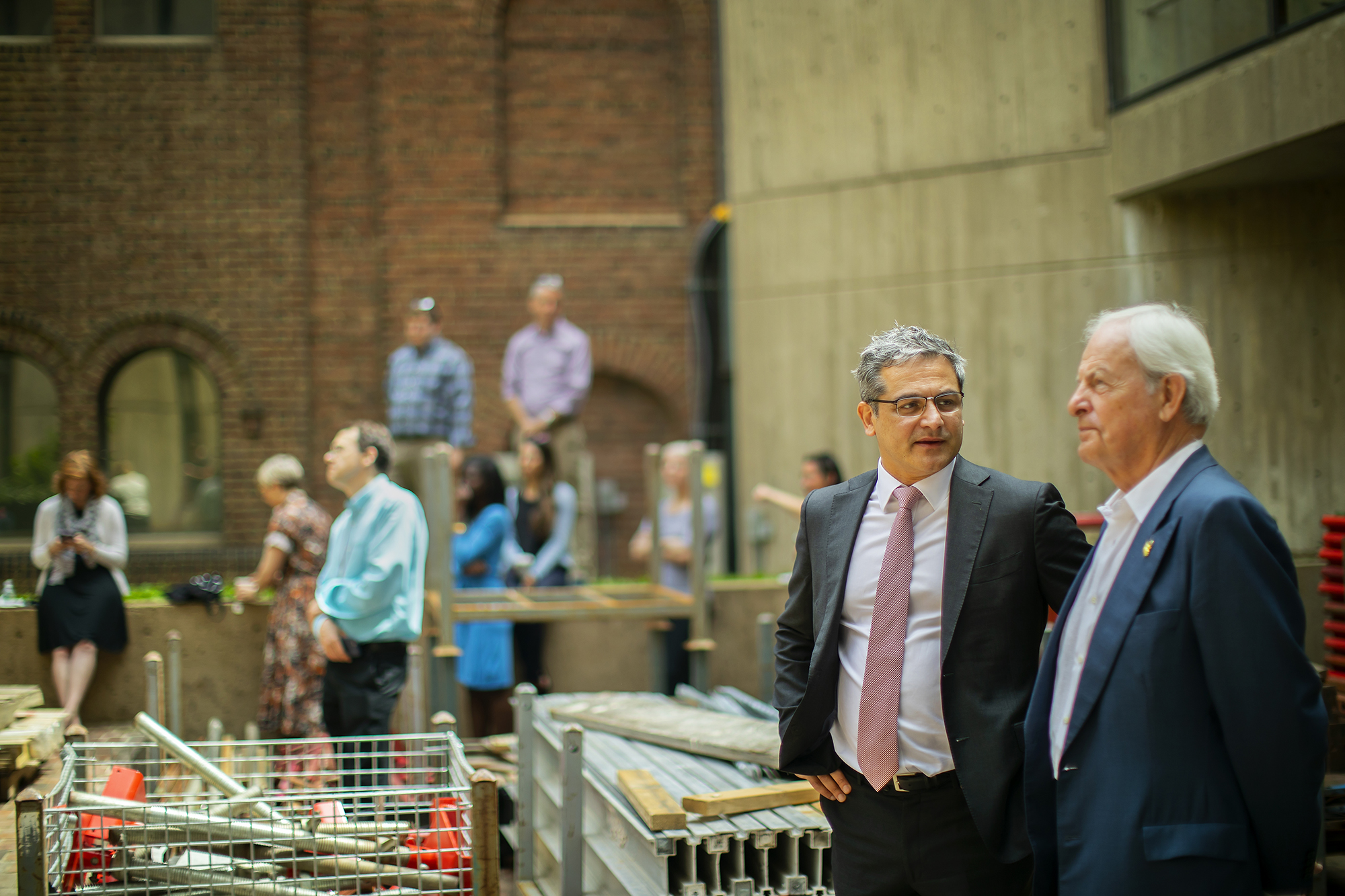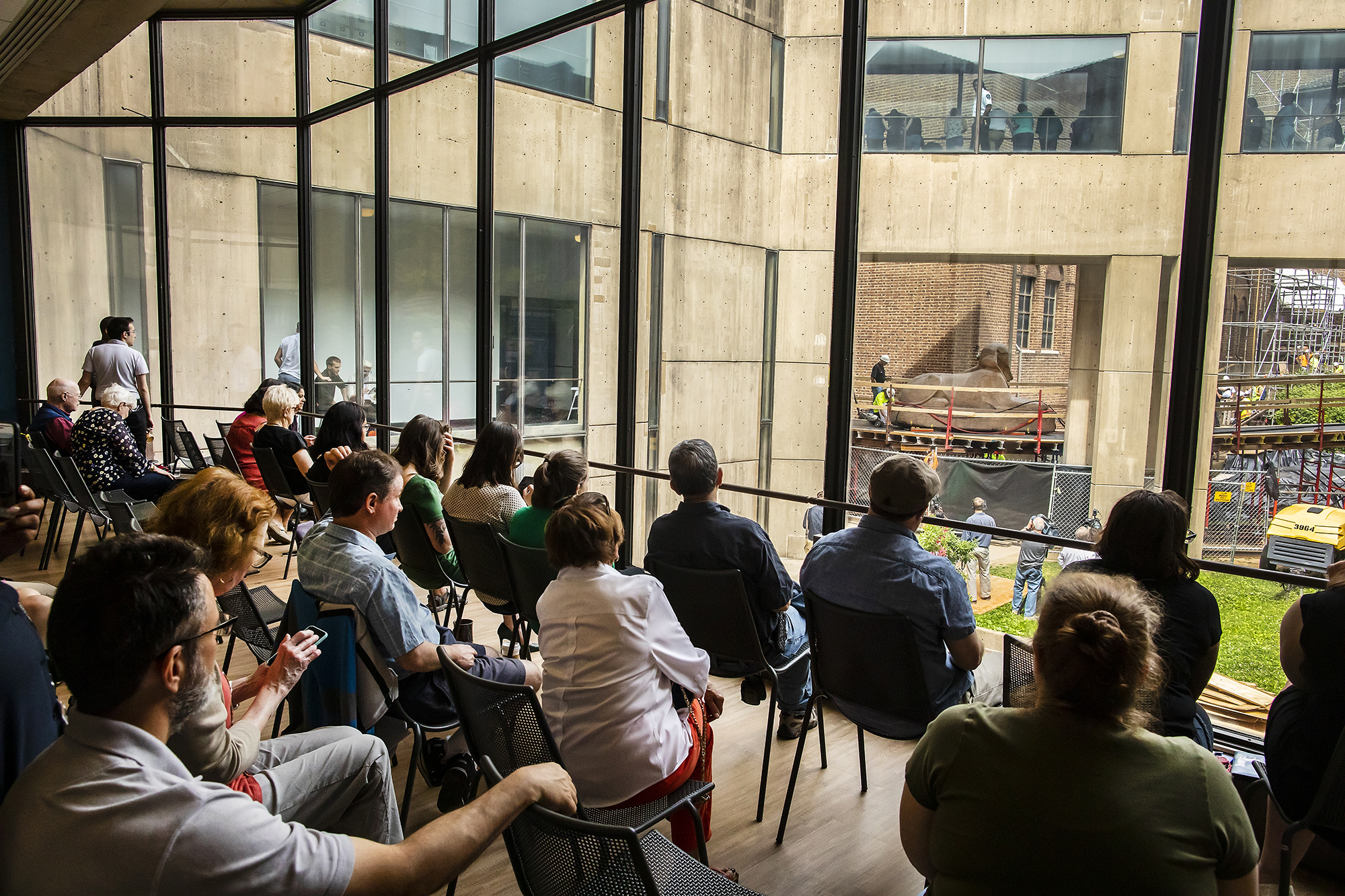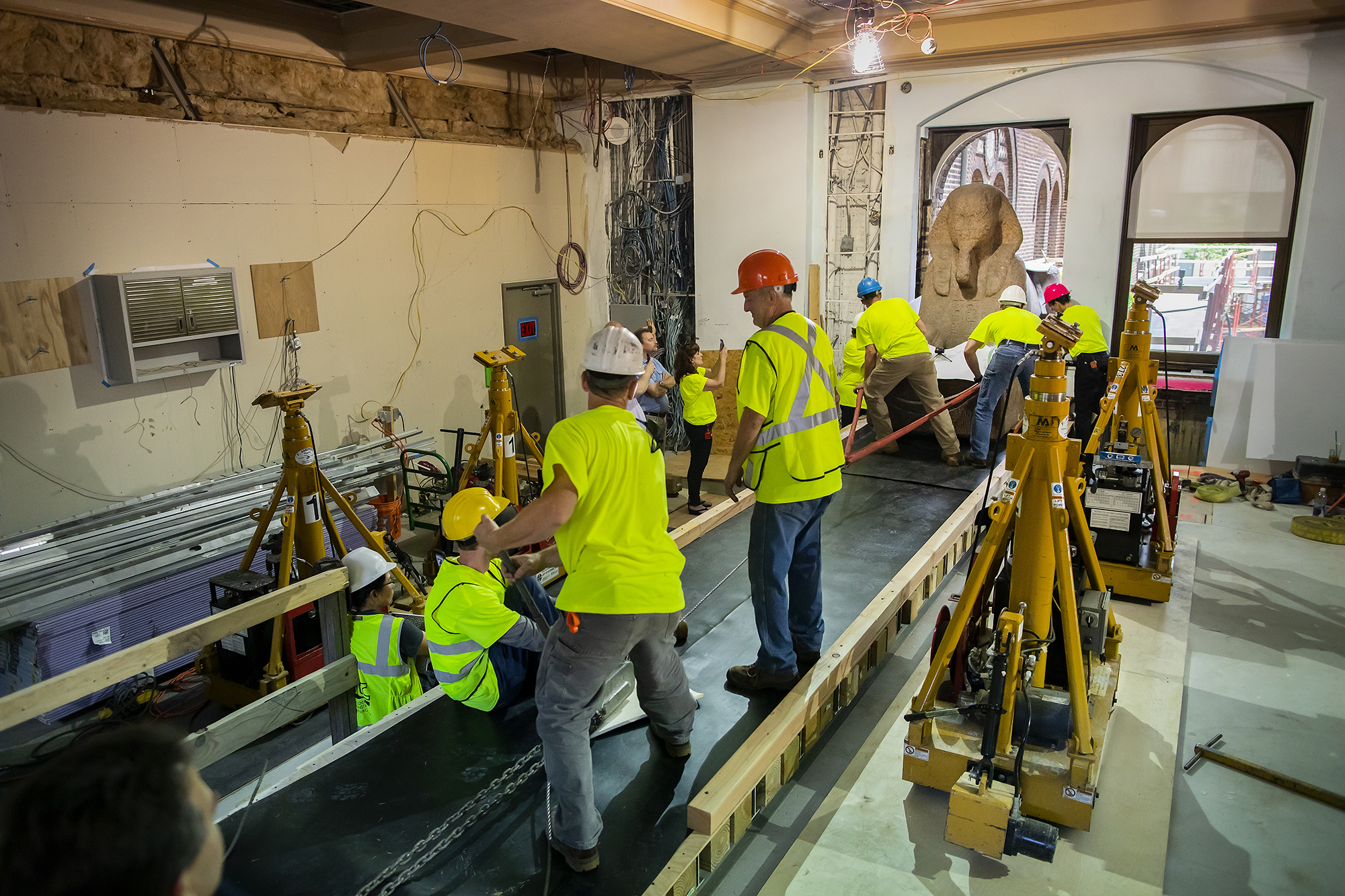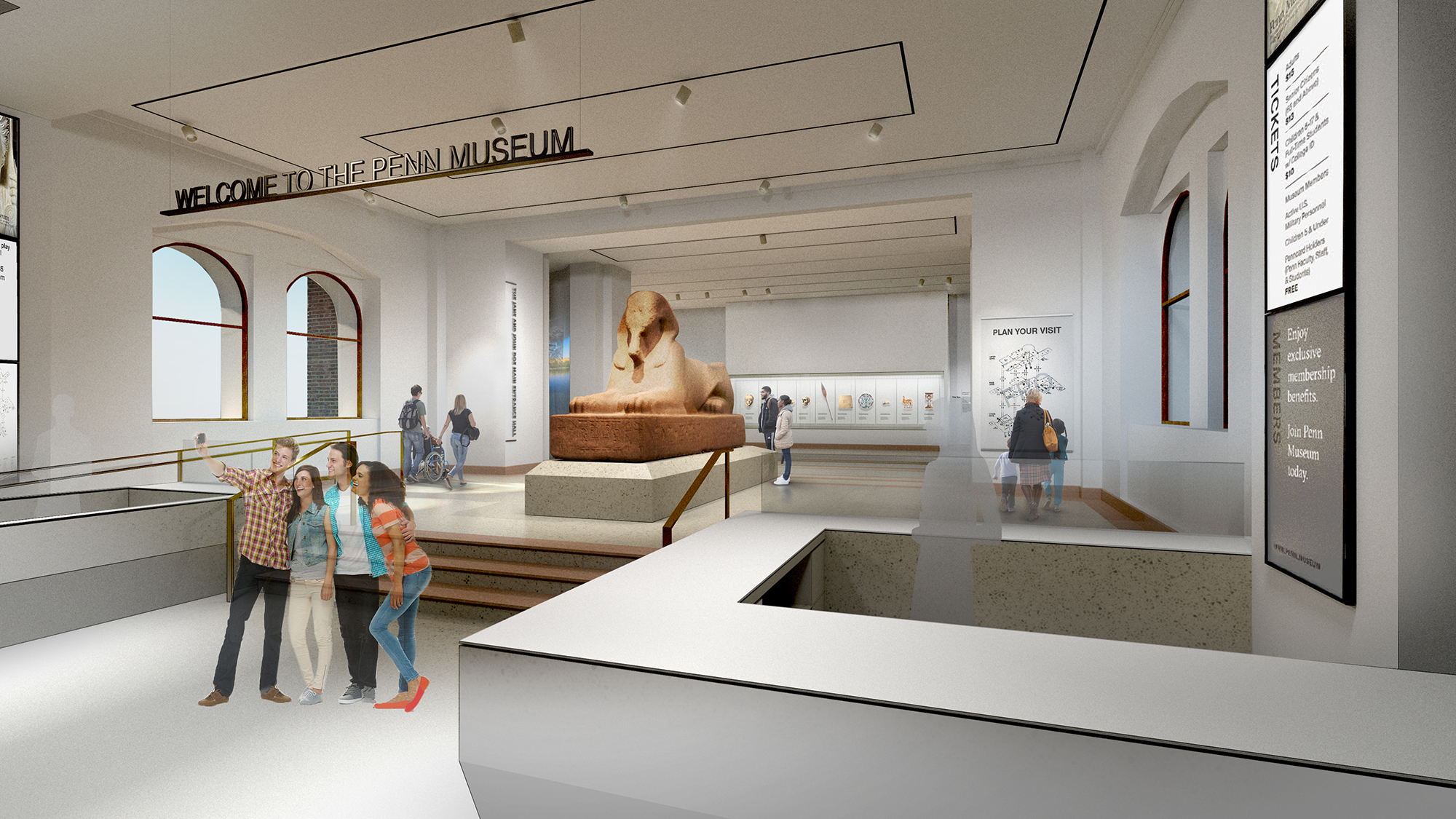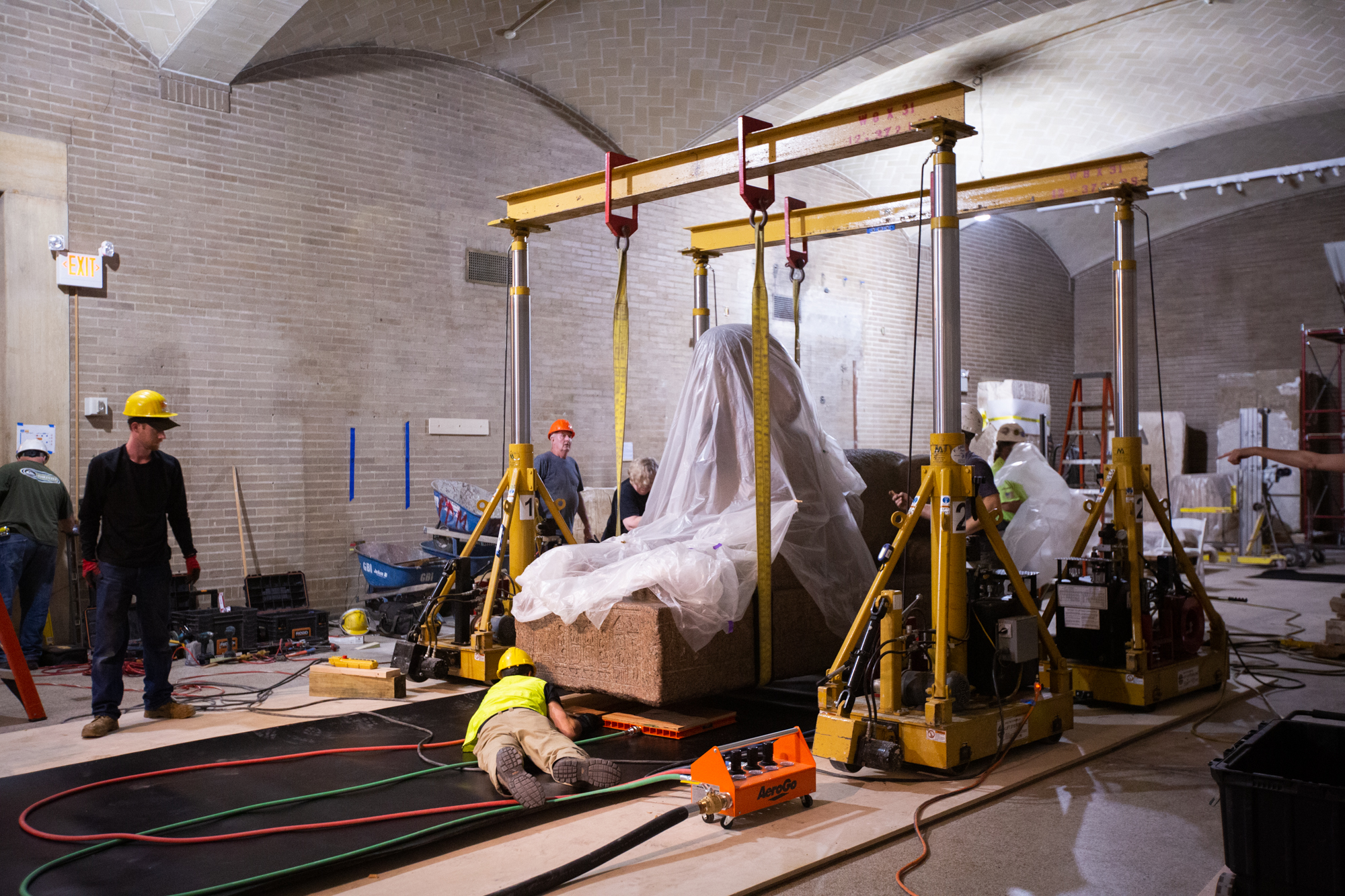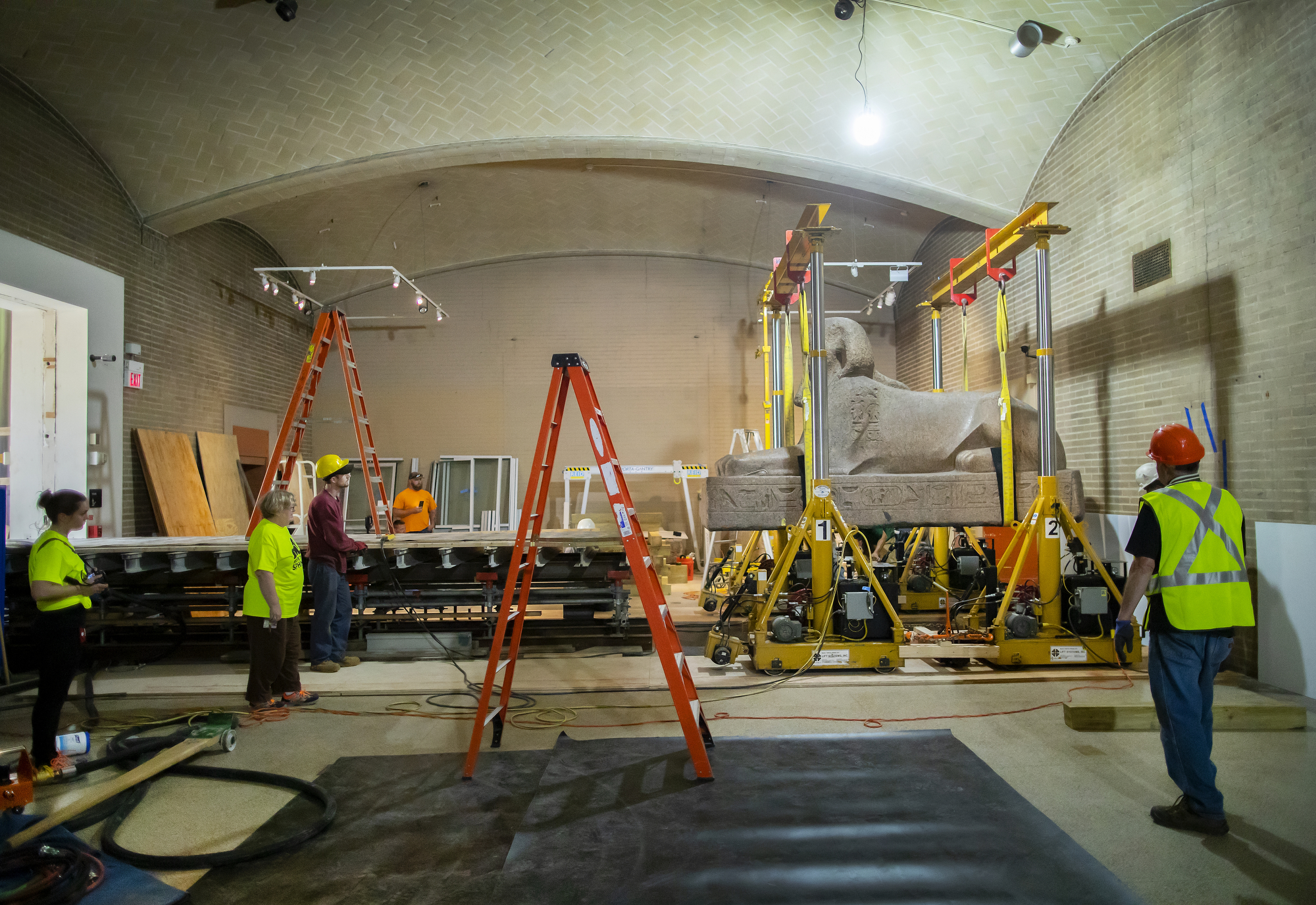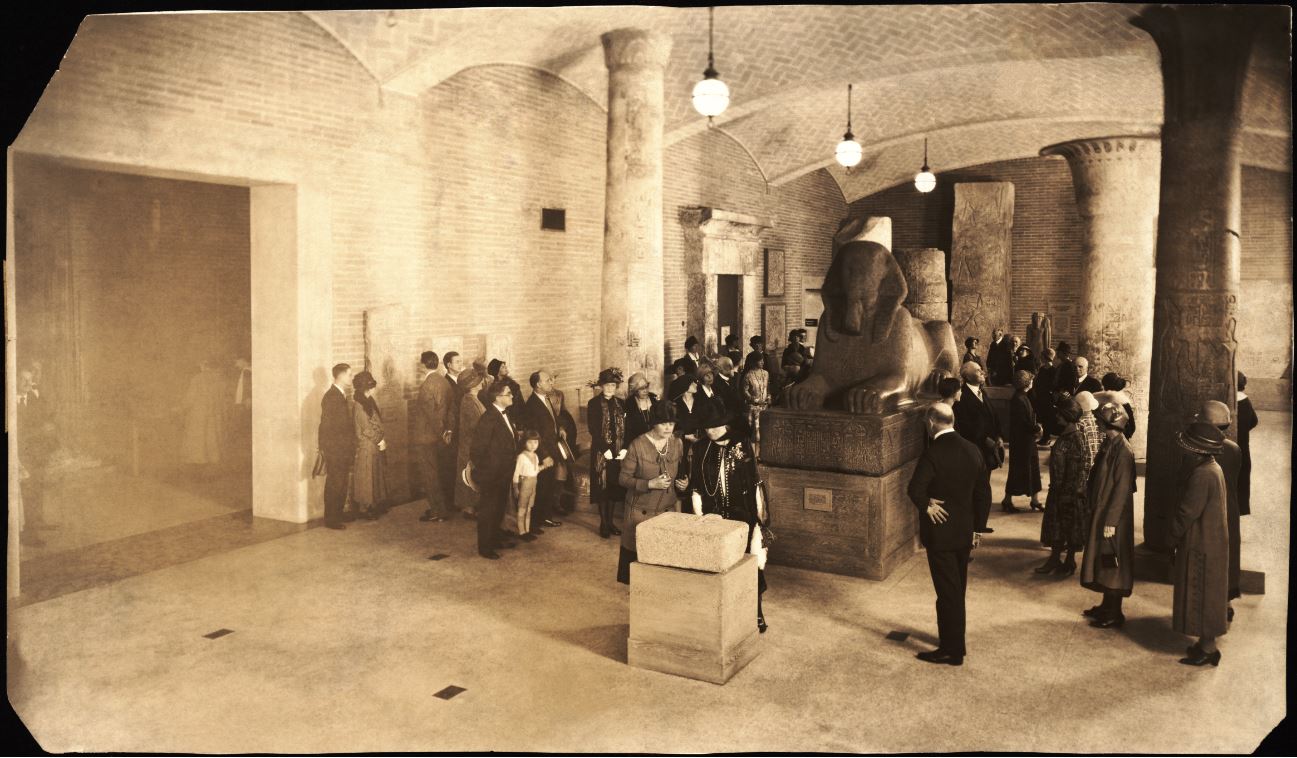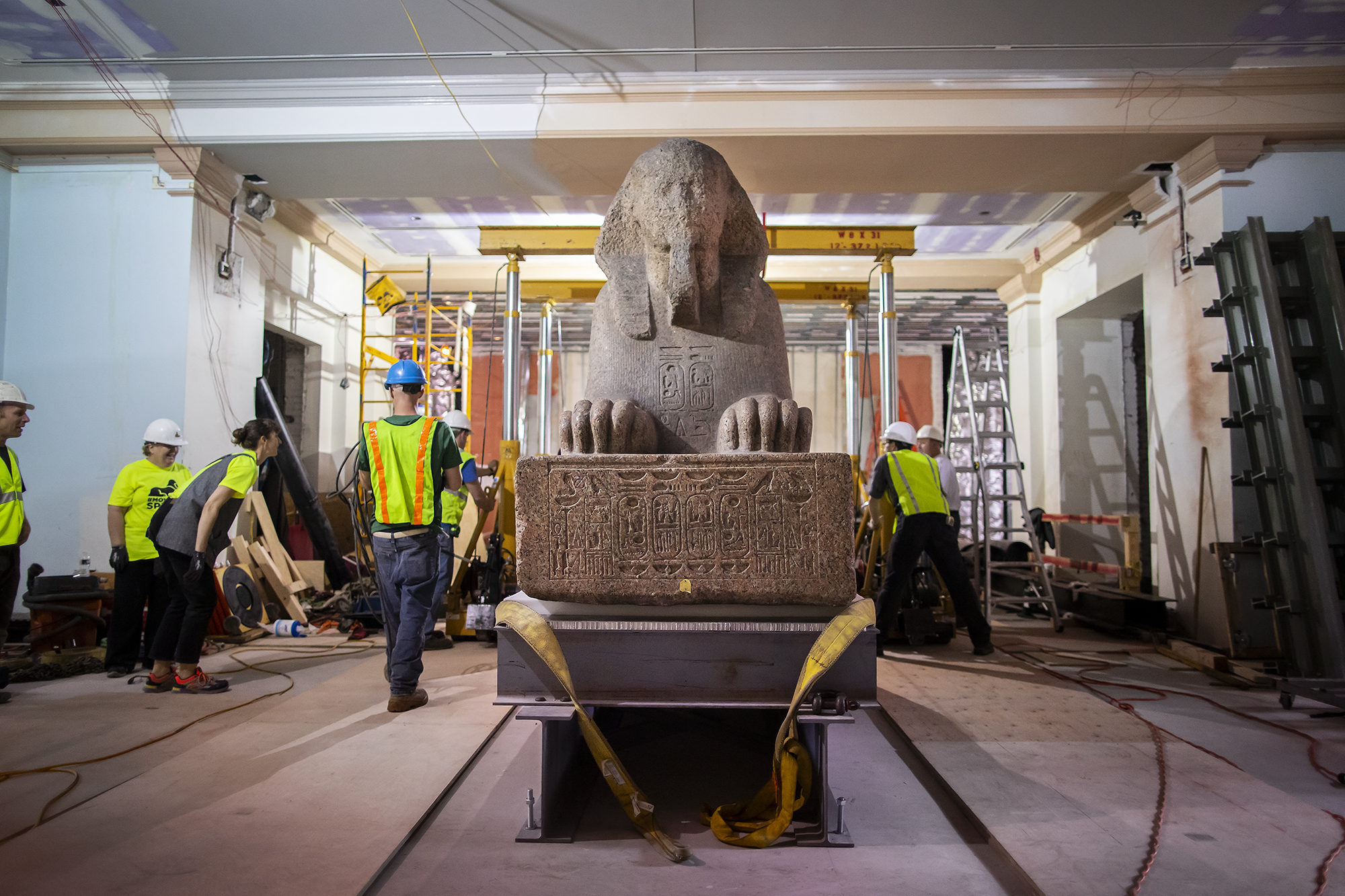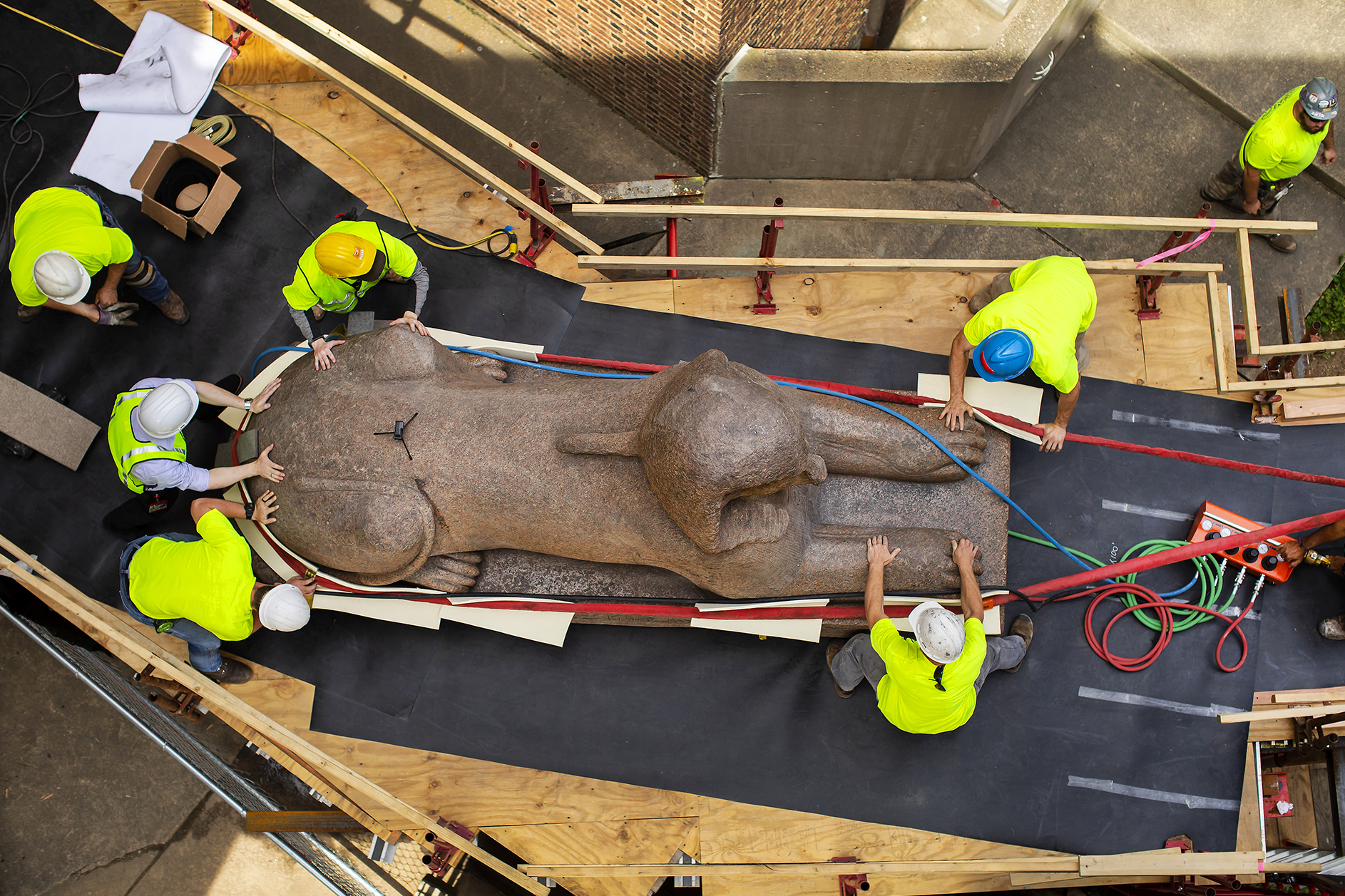
In the end, it took about six minutes for a team of half a dozen people to pull and push the colossal red granite sphinx, riding on a pillow of compressed air along an elevated wood runway in an outdoor courtyard, on the last leg of its 300-foot, three-day journey.
“Looking good,” one of the hard hat-clad movers called out, over the hiss of a compressor and the ticking of a hand-cranked winch. “That’s good, just like that.”
At just after 3 p.m. on Wednesday, with roughly an inch of clearance on each side, the 12.5-ton sphinx floated through an arched brick opening and into the main entrance hall at the University of Pennsylvania Museum of Archaeology and Anthropology.
The 3,000-year-old sphinx’s journey from the Egypt Gallery to the main entrance hall is part of the Museum’s multiyear Building Transformation project to renovate and reimagine much of the 132-year-old institution.
The sphinx will be on public view once again when the entrance hall is reopened on Nov 16. On that day, the Museum will unveil its new Mexico and Central America Gallery, Africa Galleries, and the renovated Harrison Auditorium.
“It went as smoothly as we hoped,” said Robert Thurlow, special projects manager, minutes after the sphinx was settled onto a temporary platform in the hall. “We ran into a few problems we foresaw, and we used the backup plans to our backup plans.”
Thurlow oversaw every aspect of the complex operation, planned for months, working with dozens of experts inside and outside the Museum. One of those backup plans kicked in as weather shifted the move up by a day, between rain on Monday and rain forecast for Thursday. In the early hours on the picture-perfect Wednesday, soil testers gave the thumbs up—the soil was dry enough and the pylons would hold the weight.
“This was one of the most difficult things that any of us will ever work on,” he said. “The fact that it is up here and safe, we can all feel really good about it. The sphinx is in as good of shape as when we started.”
This week’s move was the fourth for the sphinx since its first to Philadelphia from Egypt on Oct. 7, 1913. Wednesday was the first time the sphinx had been outside since it was placed in the Egypt Gallery in 1926.
300 feet in 3 days
Wednesday’s journey for the sphinx started at 10:20 a.m., when a team of workers started pushing the massive monument out of an opening in the wall of the Egypt Gallery, and along the elevated wooden runway built on steel beams and scaffolding.
When the sphinx's head emerged into the sunshine two minutes later, cheers and applause broke out from the crowd of about 100 gathered in the outside courtyard, as well as in the cafeteria and overhead walkway, many filming with their cellphones.
The sphinx was floating on a pillow of air created by four square “air dollies” fueled by high-powered air compressors, creating about a half inch of lift, making it possible to push it along, similar to a disc on an air hockey table.
At 10:24 a.m., the sphinx came to rest on the level portion of the walkway, facing the next stage, the first and longest section of two inclines totaling 91 feet.
“It’s finally out,” said Jennifer Wegner, associate curator and sphinx expert, watching from the courtyard. “The doorway was one of the worrisome spots. Now the ramp is another when the incline starts. It’s still on the track, so that’s a good sign.”
Also watching from the courtyard was Julian Siggers, Williams Director of the Penn Museum, who said he was nervous about the move, but had confidence in the operation.
“The sphinx will almost be Penn’s public face to the city. It is going to be one of the things Penn will be most proud of, because there is no other university museum like this anywhere in the country,” Siggers said, speaking over the sound of the air compressors.
“The sphinx will be the first object you see as you enter. It is our most iconic object, but it is also standing in as a representation for the complete transformation of the Museum,” he said. “Yes, it is going to be a big deal. It’s a huge moment for us. The sphinx is much-loved in Philadelphia.”
The next section of the journey was the most challenging, Thurlow said. A red strap attached to a hand-cranked winch was placed around the sphinx, cushioned by rectangles of cream-colored felt.
“The most physically challenging part was that first big incline, which is what we expected,” he said. “The transition from flat to incline was a bit more difficult because of the seam, and the grade of the slope was tricky.”
At 11:22 a.m. the sphinx was on the move again. With each pull of the winch from the front, the sphinx rocked back and forth, slowly and steadily moved forward by the team pushing from behind, coming to rest on a landing 27 minutes later, ready to make the 45-degree turn to head toward the entrance.
Just after 2 p.m., following a lunch break, the sphinx started up the final incline toward the opening to the main entrance hall. Inside watching the sphinx make its entrance at an hour later were many of the people who have been involved in the move, including Jennifer Wegner.
“They did it,” Wegner said. “We knew they could, and they did. It slid right through, as intended.”
On Thursday, the sphinx will be set on its final resting place, a spot just 20 feet back from where it was placed in 1916, brought in from outside the front of the Museum where it was placed when it arrived from Egypt in 1913.
The sphinx was moved to the Egypt Galleries in 1926, placed on a base of stacked wooden railroad ties. The walls were built around it, making another move seem impossible. Wegner thought it would never leave that gallery, and said as much in the definitive book on the sphinx she co-authored with her husband, Josef, “The Sphinx that Traveled to Philadelphia."
“When we wrote the book we said it would never, never, never leave the gallery. It is impossible, impossible, impossible. Guess what? It is possible,” she said in an early morning press conference. “So this morning another chapter in the sphinx’s journey from Egypt is about to be written with this monumental undertaking.”
Making the impossible possible
The possibility of a move arose as part of the Building Transformation project, which will renovate 44,000 square feet of space, and includes a complete renovation and reworking of the galleries for the Egyptian collection. The plan was to move the sphinx within the gallery, meaning it would be out of sight, on a "staycation," for four to six years.
But that gallery will be dedicated to telling the story of the afterlife, including the Museum’s impressive collection of mummies, Wegner said. “We couldn’t figure out how to fit the sphinx into that particular story,” she said. “Moving the sphinx freed up a lot of space.”
The green light for the sphinx move came in December, after a months-long feasibility study, which included evaluation of the floor and the pathway for the sphinx to exit the gallery and enter the entrance hall.
Bricks were removed to make the openings, once windows, as wide as possible, but steel support beams left only an inch and a half of clearance on each side of the final opening.
“It was very close. It was tighter than we wanted,” Thurlow says. “We had a lot of architectural restrictions we were up against.”
This week's move required the sphinx be lifted four times with heavy equipment known as a gantry, two hydraulic jacks holding two large straps positioned under the sphinx.
On Monday at 2:24 p.m., the sphinx was first lifted off of its railroad tie base, suspended in the air for five minutes as the base was pulled away. Then it was lowered to wooden beams on the floor, leaving enough room to put the air dollies in place.
The following day, the sphinx was moved 68 feet through the gallery, riding along the air cushion, pushed by a team of four men. The sphinx was pivoted 45 degrees and then pushed on the side to line up with the end of the wooden runway.
The second lift by the gantries suspended the sphinx in the air, and then moved it forward far enough to place it on the wooden runway 40 inches above the floor, ready for the move outside on Wednesday.
The floor capacity was a major consideration, both for the move, as well as for the future gallery, Thurlow said. They installed “post shores,” floor-to-ceiling jacks, under the floor in the Egypt Gallery along the route of the move. And the entrance hall floor has reinforced concrete to support more than 500 pounds per square inch.
No horses necessary
The high-tech move is a contrast to the sphinx’s move to Philadelphia back in 1913. The sphinx was discovered in 1912 in the Temple of the God Ptah at Memphis, Egypt, by English archaeologist W.M. Flinders Petrie and his team, buried up to its shoulders, with its exposed head subject to erosion from the elements.
The sphinx, with the head of a human and the body of a lion, depicts the Egyptian Pharaoh Ramses II, who reigned for 67 years. Dated to 1294 to 1185 BCE, it is the largest ancient sphinx in the Western Hemisphere and the fourth largest outside of Egypt.
Offered to the Penn Museum by Petrie, in 1913 the sphinx traveled more than 6,000 miles by ship, arriving to a South Philadelphia pier on October 7. The ship moved up the Delaware River to Port Richmond where a large railroad crane put it on a railway car.
The sphinx traveled to the end of the train line at 23rd and Arch streets, and then by horse-drawn cart up 33rd street to the Museum, drawing a crowd from the Penn-Brown football game in Franklin Field, according to Wegner’s book. On Oct. 20, the sphinx was finally situated in the courtyard, moved over a wall by more than 50 men using a wooden derrick, beams, and a hoist.
The price tag for the move from Egypt was $794.02, compared with the cost of the move this week of about $850,000.
Very relieved
What kept Thurlow up at night before the move?
“We have never done anything like this before. There is such an element of the unknown,” Thurlow said. “We have backup plans upon backup plans upon backup plans for this.”
On Thursday, the team will move the sphinx to the permanent base made of reinforced steel weighing 2,030 pounds. The maneuver will require that the sphinx be lifted two more times, once to get it off of the temporary platform and onto the floor, and then after a 90-degree turn on the air dollies, the fourth and final lift to place it on the base.
“I feel very relieved right now,” Thurlow said while standing by the sphinx in the entrance hall. “I’m sure later tonight I’ll feel ecstatic, but right now I’m relieved.”




